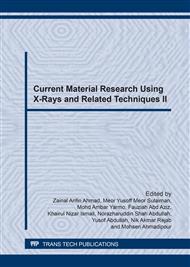p.136
p.141
p.146
p.151
p.157
p.162
p.167
p.175
p.179
The Effect of Flux to Physical and Chemical Properties of Ceramic Body Using Ball Clay from Kampung Dengir, Besut, Terengganu
Abstract:
The fluxing agent usually used to reduce the sintering temperature of ceramic production. In order to achieve this study, the potassium feldspar had used as a fluxing agent in range between 15.2 - 42.5 %. The mixture of slurry was formulated by using ball clay, silica, polyethylene glycol and potassium feldspar to produce the ceramic pieces. The sample was prepared by aging the mixed clay with additives and aging for 24 hours before casting on the flat mould to form rectangular ceramic pieces. The body pieces then undergo thermal treatment at temperature of 800C, 900°C, 1000°C, 1100°C and 1200°C for 2 hours with heating rate 5°C/min as to study the effect of flux towards sintering behavior of the samples. The characterization of the samples was conduct in order to study the chemical composition of sample. The effect of the fluxing agent towards sintering temperature was evaluated in order to investigate the firing shrinkage, density, porosity and water absorption. The result shows at temperature of 1100°C with increasing the amount of flux, the firing shrinkage decreasing from 18 to 13 %. Increasing the amount of flux had decrease the porosity and water absorption of ceramic pieces and the density of the ceramic pieces almost uniform. The optimum amount of flux was 42.5% and sintering temperature was 1100°C.
Info:
Periodical:
Pages:
157-161
Citation:
Online since:
March 2017
Keywords:
Price:
Сopyright:
© 2017 Trans Tech Publications Ltd. All Rights Reserved
Share:
Citation:


